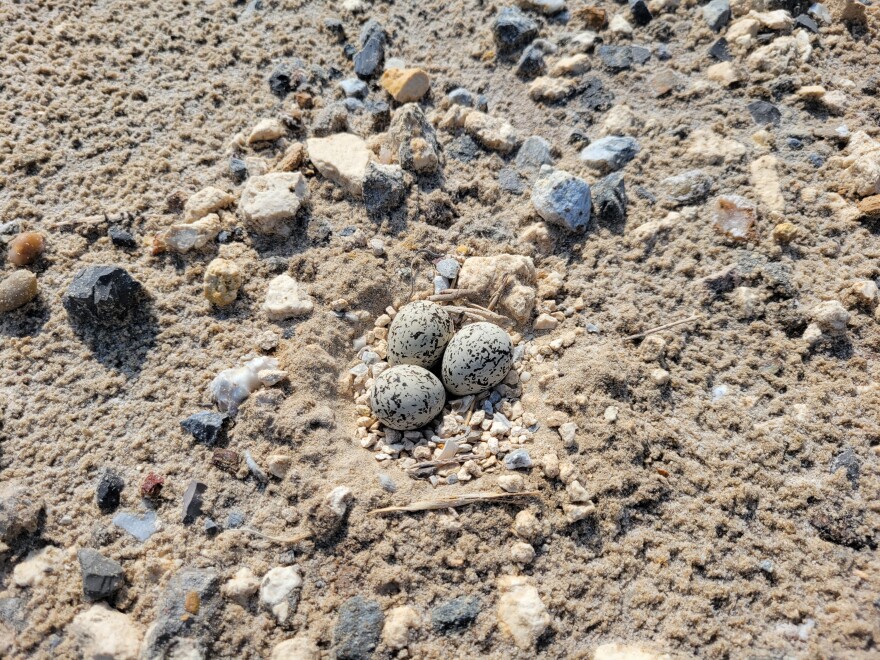Two months after SpaceX launched its first Starship/SuperHeavy prototype from its South Texas facility, concrete debris from the destroyed launch pad is still strewn across some parts of Boca Chica Beach.
Native shorebirds have returned to the area, just south of the launch pad, and made nests around — and out of — the debris.
Justin LeClaire, a conservation biologist with the Coastal Bend Bay and Estuaries Program, found seven Snowy Plover nests, a Wilson’s Plover nest, and several Least Tern nests while surveying around the launch pad last week. Most of them were within a quarter mile of the launch pad — the closest was just a few hundred feet away.
“These birds think that [area] is good habitat now, potentially,” LeClaire said. “We know for a fact that that's not a good place to nest right now.”
The shorebirds likely began building nests near the launch pad because storms in other parts of Boca Chica destroyed previous nesting attempts, LeClaire explained. With an abundance of small rocks and indentations in the sand — both of which the shorebirds use to build nests — the area is attractive to the birds.

But with SpaceX planning a static fire test this week and another launch in a month, the presence of nests raised questions about how the birds would fare during the event.
“A bird's not going to sit on its nest a few hundred feet from the launch pad during a static fire or, obviously, a test,” LeClaire said. “And so not only are [the birds] going to be disturbed off their nest, there's the question: are [the nests] going to be abandoned? Are they going to be physically injured by that kind of pressure, depending on how many engines are being tested or if the shuttle is actually being launched? So there's a lot of unknowns there.”
Though some debris was initially removed by SpaceX in the days and weeks following the Starship/SuperHeavy launch, it has since stopped.
The Texas Parks and Wildlife Department (TPWD) requested that SpaceX halt debris removal until September so as not to disturb the shorebirds’ nesting season. A spokesperson told TPR that the agency is still coordinating with SpaceX on removing the debris and added that the concrete didn’t pose an “immediate hazard” to the ecosystem.

LeClaire said picking up all of the debris in Boca Chica will be difficult because the habitats surrounding SpaceX’s launch pad are sensitive. The shorebirds, namely the plover species, are using the smallest pieces of debris.
“But then you've got to look at what size debris are you going to pick up? Are you only going to get the big things?” LeClaire said, referring to the logistics of the debris recovery. “And how are you going to get it out, especially like the stuff out on the algal flats? You could drive the heavy machinery out there if it's dry, but it's going to do damage.”
Algal flats are mudflats with a layer of algae and biofilm on top of them, which some species of shorebirds use as a source for food.
During debris recovery after the 2020 and 2021 Starship launches, heavy machinery and ATVs were used to pull large pieces of metal from the rockets out of the algal flats north of the launch pad. The scars and tire marks are still there, highlighting the sensitivity of the area.

To prevent destroying the launch pad again and to remain in line with other space exploration projects, SpaceX is building a water deluge system with a cold steel plate under the launch tower. The company tested that launch infrastructure against one engine at its facility in McGregor, Texas, last month.
The latest iteration of Starship will have 33 engines, like the previous model that exploded four minutes after takeoff.
SpaceX still needs to get clearance from the Federal Aviation Administration (FAA) for its second flight, however. The agency, which is facing a lawsuit for issuing SpaceX a launch license in Boca Chica, grounded the Starship from flying again after the April 20 launch, pending an investigation of the damage. In late May, SpaceX joined the lawsuit as a co-defendant alongside the FAA.
SpaceX did not respond to TPR’s request for comment.



